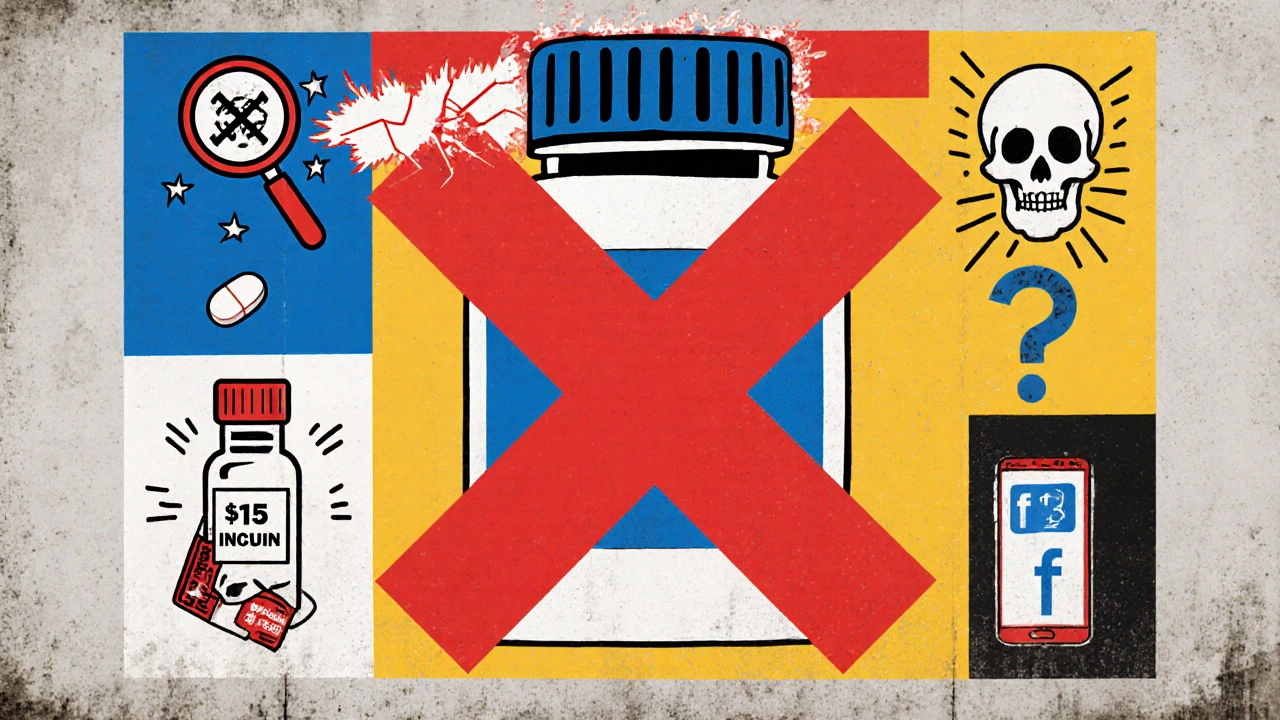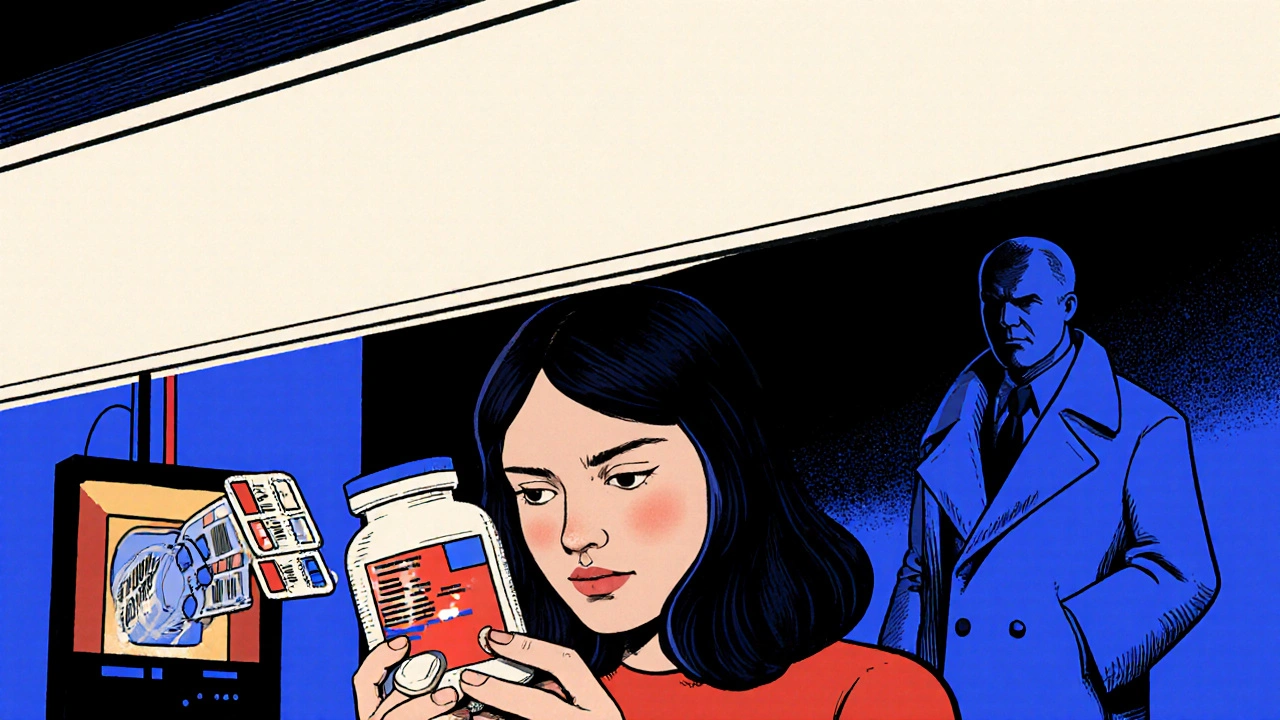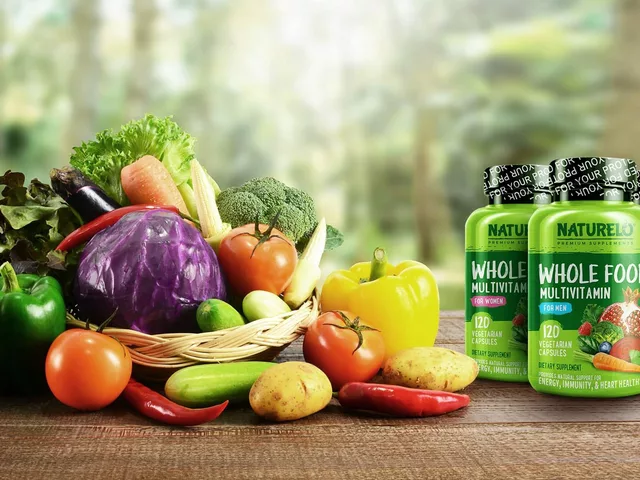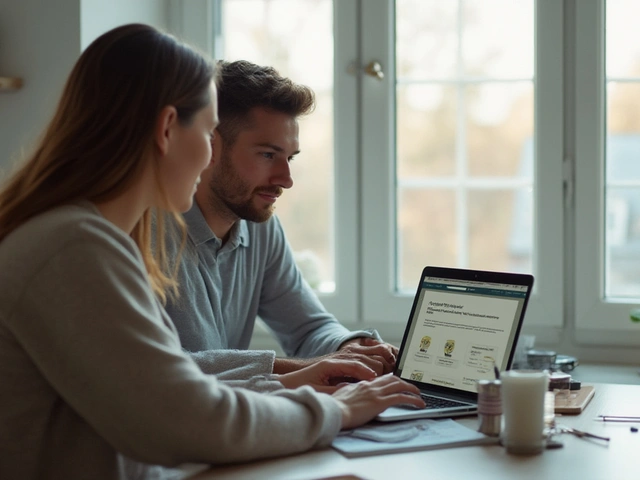Counterfeit Drug Spotter
Check if your medication might be counterfeit using the 5 critical warning signs outlined by health authorities. If multiple red flags appear, stop taking the medication immediately and contact your doctor.
Counterfeit medications aren’t just a problem in distant countries-they’re in your medicine cabinet
You open a bottle of pills you bought online. The label looks right. The blister pack seals cleanly. But the tablet feels lighter. It doesn’t dissolve the way it used to. A week later, your headache won’t go away. Your fever spikes again. You didn’t get the medicine you paid for-you got a fake.
Every year, counterfeit medications kill tens of thousands and sicken millions. The World Health Organization says nearly 1 in 10 medicines in low- and middle-income countries are fake or substandard. But this isn’t just a problem overseas. In the U.S., 97% of online pharmacies selling prescription drugs are illegal. And the most dangerous fakes? They look real. So real, even pharmacists miss them.
Counterfeit drugs don’t just lack active ingredients. They might contain rat poison, cement, or deadly doses of fentanyl. In 2024, the DEA seized over 61 million fake pills-most of them made to look like oxycodone or Xanax. Seven out of ten contained enough fentanyl to kill an adult. These aren’t scams. They’re weapons.
How fake drugs are made-and why they’re getting harder to spot
Years ago, counterfeit pills were easy to catch. Bad spelling. Cracked packaging. Pills that were the wrong color or shape. Today, criminal labs use 3D printers to replicate blister packs. They copy holograms. They even mimic the exact texture of real tablets. Some fakes contain just enough active ingredient to fool quick tests-enough to make you feel better temporarily, but not enough to treat your condition. That’s how they trap you.
According to the Pharmaceutical Security Institute, 6,424 incidents of counterfeit drug activity were recorded in 2024 across 136 countries. The targets? High-demand drugs: insulin, antibiotics, cancer treatments, blood pressure pills, and painkillers. Criminals know people will risk anything for a cheap cure.
One Reddit user, a nurse named MedTech_RN, shared how her father nearly died after taking counterfeit insulin. The packaging was flawless. The vial looked identical. But it weighed 12% less. The insulin had no active ingredient. He slipped into a coma. He survived. Others don’t.
Why are these fakes so convincing now? Because the criminals are copying the real thing. The International Federation of Pharmaceutical Manufacturers & Associations says counterfeiters now replicate serialization codes, QR codes, and even tamper-evident seals. They’ve cracked the code-and they’re selling it on Instagram, Facebook, and fake websites that look like CVS or Walgreens.
Where counterfeit drugs come from-and how they reach you
Most fake drugs start in Asia. China, India, and Pakistan are major production hubs. But they don’t stay there. They’re shipped through global supply chains, repackaged in warehouses in Eastern Europe, and sold via websites pretending to be Canadian pharmacies. The FDA says 85% of drugs sold from sites claiming to be Canadian actually come from other countries-often with no oversight.
Here’s how it works: You search for “buy metformin cheap online.” You click a site that looks legit. It has a .pharmacy domain. It asks for your prescription. You send it. Two days later, a box arrives. No customs forms. No tracking updates. You pop a pill. You feel fine. For now.
But behind that site? A criminal network using encrypted apps like Telegram and Signal. They’re paid in Bitcoin. They ship through drop boxes. They change domains every week. In 2025, Interpol’s Operation Pangea XVI shut down 13,000 websites and arrested 769 people. But for every site taken down, ten pop up.
And the worst part? You’re not protected by law. If you buy from an illegal online pharmacy, you have no recourse. No refund. No complaint process. No FDA oversight. If the pills kill you, there’s no one to sue.
How to spot a fake medicine-5 red flags you can’t ignore
You don’t need a lab to tell if your medicine is real. Here are five signs that something’s wrong:
- Unusual packaging: Look for blurry text, mismatched fonts, or misspellings. Even small errors like “Amlodipine” spelled as “Amlodipen” are red flags. Compare the box to the manufacturer’s official image on their website.
- Wrong color or texture: If your pills are a different shade, shape, or feel gritty, chalky, or oily, don’t take them. Real pills have consistent finishes. Fake ones often look painted or molded.
- Odd smell or taste: Some fake pills smell like plastic or chemicals. Others taste bitter, metallic, or sour. If it doesn’t smell or taste like it used to, stop using it.
- No prescription required: Any website that sells prescription drugs without one is illegal. Period. If they offer “instant approval” or “no doctor visit needed,” it’s a scam.
- Price that’s too good to be true: If a 30-day supply of insulin costs $15 online, it’s fake. Real insulin costs hundreds. If a brand-name cancer drug is half the price at a “Canadian pharmacy,” it’s not Canadian. It’s dangerous.
And don’t trust social media sellers. A 2025 survey by the National Consumers League found that 41% of people bought medications from sites that didn’t require prescriptions. That’s how people end up with fakes.
How to buy medicine safely-step by step
You need medicine. You want it safe. Here’s how to do it:
- Only buy from licensed pharmacies: In the U.S., look for the VIPPS seal (Verified Internet Pharmacy Practice Sites) from the National Association of Boards of Pharmacy (NABP). Click it. It should link to NABP’s verification page. If it doesn’t, walk away.
- Use the FDA’s database: Go to the FDA’s National Drug Code (NDC) directory. Enter the code on your pill bottle. If it doesn’t match the manufacturer’s record, it’s fake.
- Check the manufacturer’s website: Pfizer, Novo Nordisk, and other big pharma companies have public image galleries of their packaging. Compare your bottle side by side.
- Don’t buy from international sites: Even if they claim to be “licensed,” they’re not regulated by U.S. standards. The FDA doesn’t inspect them.
- Report suspicious drugs: Use the WHO’s MedSafety app or report to the FDA’s MedWatch program. Your report could save a life.
For people in Australia, use the Therapeutic Goods Administration (TGA) website to check if a medicine is approved. If it’s not listed, it’s not legal-and likely fake.

Why this matters more than you think
Counterfeit drugs aren’t just a personal risk-they’re a public health crisis.
When people take fake antibiotics, they don’t get cured. They survive, but the bacteria don’t die. They adapt. That’s how antimicrobial resistance grows. The WHO says counterfeit medicines are fueling a global superbug pandemic. In Africa, fake antimalarials kill over 120,000 people a year. In Nigeria, where 40% of medicines are counterfeit, people are dying from “miracle cures” that vanish after a few days.
And the economic cost? $83 billion in fake drugs sold each year. Legitimate drug companies lose $200 billion. But the real cost? Lives. Pain. Misdiagnosis. Delayed treatment. Death.
The technology to detect fakes is improving. Portable spectroscopy devices can scan a pill in seconds. But they’re expensive. Most people don’t have them. So you have to be your own first line of defense.
What to do if you think you’ve taken a fake
If you suspect your medicine is fake:
- Stop taking it immediately.
- Keep the packaging. Don’t throw it away. Take photos of the bottle, label, and pills.
- Contact your doctor. Tell them what you took and when. They may need to run tests.
- Report it. Use the FDA’s MedWatch system (U.S.) or the TGA’s online reporting tool (Australia). Include photos, batch numbers, and where you bought it.
- Don’t tell friends to buy it. This isn’t a cautionary tale-it’s a public safety alert.
One woman in Sydney bought fake blood pressure pills from a website she found on Google. She felt dizzy. She thought it was stress. Two weeks later, she had a stroke. She survived. But her doctor said: “If you’d taken the real medicine, this wouldn’t have happened.”
Can counterfeit drugs be detected at home without special tools?
Yes. While lab equipment like spectroscopy devices can confirm authenticity, you can spot many fakes at home. Check for spelling errors on the label, mismatched colors or shapes of pills, unusual smells, or packaging that feels flimsy. Compare your medicine to images on the official manufacturer’s website. If the pill doesn’t dissolve the same way as before, or if the bottle feels lighter, those are warning signs. Never ignore small inconsistencies-they’re often the only clues you’ll get.
Are online pharmacies from Canada safe?
Most are not. The FDA estimates that 85% of websites claiming to be Canadian pharmacies actually ship from countries with no drug safety standards. Even if they look legitimate, they often bypass U.S. and Australian regulations. Only buy from pharmacies with the VIPPS seal from the NABP, and make sure they require a valid prescription. If they don’t, they’re illegal-and their drugs are risky.
Do fake drugs contain dangerous substances?
Yes. Many counterfeit pills contain fentanyl, rat poison, cement, or industrial dyes. In 2024, the DEA found that 7 out of 10 fake painkillers seized contained lethal doses of fentanyl. Fake insulin has been found with no active ingredient at all. Fake antibiotics often contain just enough drug to make you feel better temporarily-but not enough to kill the infection, which leads to antibiotic resistance. These aren’t mistakes. They’re deadly products made for profit.
Why are counterfeit drugs more common in low-income countries?
Weak regulation, lack of enforcement, and limited access to affordable medicine make low-income countries easy targets. In places like Nigeria and parts of Africa, up to 40% of medicines are counterfeit. People buy them because they have no other option. Criminals exploit this by selling cheap fakes that mimic real drugs. The WHO estimates 1 in 10 medicines in these regions are falsified or substandard-putting two billion people at risk.
Can 3D printing make counterfeit drugs worse?
Yes. Criminal groups are now using desktop 3D printers to replicate blister packs, labels, and even holograms. These machines can produce convincing packaging at low cost. While they can’t yet replicate the chemical composition of complex drugs like biologics, they can make fake versions of pills and capsules that look identical to the real thing. This makes detection harder and increases the risk of people trusting fakes that look perfect.
What should I do if I bought medicine from a suspicious website?
Stop using the medicine immediately. Keep the packaging and take clear photos. Contact your doctor or pharmacist to discuss possible side effects or health risks. Report the website to your country’s health authority-FDA MedWatch in the U.S., TGA in Australia, or the WHO’s MedSafety app. Don’t wait for symptoms. Fake drugs can cause harm even if you feel fine now.
Next steps: Protect yourself and others
Don’t assume you’re safe because you’ve never seen a fake. The next one could be in your next bottle. Check your medicine. Verify your pharmacy. Report anything strange. And talk to your family. Your grandmother might not know how to spot a fake pill. Your teenager might buy painkillers off Instagram. Make sure they know what to look for.
Real medicine saves lives. Fake medicine kills. You don’t need a degree to protect yourself. You just need to look closely-and never trust a deal that seems too good to be true.






Nicole M
November 12, 2025 AT 14:58Arpita Shukla
November 14, 2025 AT 06:10Mark Rutkowski
November 15, 2025 AT 21:41Ryan Everhart
November 17, 2025 AT 06:30David Barry
November 17, 2025 AT 11:04Alyssa Lopez
November 19, 2025 AT 10:44Alex Ramos
November 20, 2025 AT 13:52edgar popa
November 21, 2025 AT 20:02Eve Miller
November 22, 2025 AT 00:31